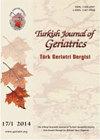影响老年门诊患者药物相互作用的因素及其临床意义
IF 0.3
4区 医学
Q4 GERIATRICS & GERONTOLOGY
Turkish Journal of Geriatrics-Turk Geriatri Dergisi
Pub Date : 2023-06-01
DOI:10.29400/tjgeri.2023.336
引用次数: 0
摘要
引言:多药治疗可导致药物相互作用。本研究的目的是确定影响老年门诊患者药物相互作用的患病率和临床重要性的可能因素,以及药物相互作用临床意义的患者间可靠性。材料和方法:在这项横断面回顾性研究中,对228名在老年门诊接受治疗的患者的潜在药物相互作用进行了评估。老年病学家和临床药剂师分别对相互作用的潜在意义进行了审查。结果:共开出1342种药物(每位患者的中位数为6[2-14])。患者的平均年龄为78±0.5(65-96)岁。64.0%的患者存在多药治疗。患者年龄与用药数量呈弱正相关(Rs=0.205;p=.002)。18.0%的患者未检测到药物相互作用。在其余187名患者的处方中,检测到760例C类、70例D类和18例X类相互作用(Lexicomp®)。发现每位患者的药物数量与药物相互作用数量之间存在强正相关关系(Rs=.734;p<.001)。相互作用数量与多药治疗的存在之间存在强相关性(rpb=.702,p<.001。结论:高龄、合并用药频率较高以及多药治疗是临床医生需要意识到药物相互作用的因素。临床药剂师可以在门诊与老年病学家合作,防止药物相互作用。关键词:药物相互作用;多药治疗;老年人保健服务;药剂师。本文章由计算机程序翻译,如有差异,请以英文原文为准。
Factors affecting drug interactions and their clinical importance in geriatric outpatients
Introduction: Polypharmacy can lead to drug-drug interactions. The aim of this study was to determine the possible factors affecting the prevalence and clinical importance, and interrater reliability of clinical significance of drug interactions in geriatric outpatients. Materials and Method: Potential drug-drug interactions in 228 patients treated in an outpatient geriatric clinic were evaluated in this cross-sectional, retrospective study. The potential significance of the interactions was reviewed separately by a geriatrician and a clinical pharmacist. Results: A total of 1342 drugs were prescribed (median 6 [2-14], per patient). Mean age of the patients was 78±0.5 (65-96). Polypharmacy was present in 64.0% of the patients. A weak positive correlation was found between patient age and the number of drugs used (Rs =.205; p=.002). No drug interaction was detected in 18.0% of the patients. In the prescriptions of the remaining 187 patients 760 category C, 70 category D, and 18 category X interactions (Lexicomp®) were detected. A strong positive correlation was found between the number of drugs per patient and the number of drug interactions (Rs =.734; p<.001). There was a strong correlation between the number of interactions and the presence of polypharmacy (rpb=.702, p<.001). The measure of agreement between the clinicians was more pronounced for category D and X interactions (Cohen’s k=.714 and 1, p<.001). Conclusion: Advanced age, a higher frequency of concomitant use of drugs, and polypharmacy are factors that require clinicians to be aware of drug-drug interactions. Clinical pharmacists can work with geriatricians in outpatient clinics to prevent drug interactions. Keywords: Drug Interactions; Polypharmacy; Health Services for the Aged; Pharmacist.
求助全文
通过发布文献求助,成功后即可免费获取论文全文。
去求助
来源期刊

Turkish Journal of Geriatrics-Turk Geriatri Dergisi
GERIATRICS & GERONTOLOGY-
CiteScore
0.60
自引率
0.00%
发文量
46
审稿时长
6-12 weeks
期刊介绍:
Turkish Journal of Geriatrics is a peer-reviewed journal. Official language of the journal is English. Turkish Journal of Geriatrics invites submission of Original Articles based on clinical and laboratory studies. Review Articles are published only after the invitation from the Editorial Board.
 求助内容:
求助内容: 应助结果提醒方式:
应助结果提醒方式:


